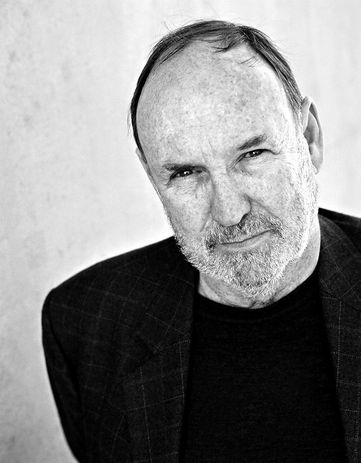Peter Salhani: What’s the most important improvement that needs to be made to ease traffic in Sydney and improve public transport?

Lawrence Nield.
Image: Vikky Wilkes
Lawrence Nield: That’s a big ask. I was a supporter of the metro rail, the lighter rail, which was quite well considered. It would have had a major impact on Victoria Road, whereas going back to heavy rail won’t have the same impact. I don’t think heavy rail is a bad system; as the master planner for the Olympic Games, I fought long and hard to bring the heavy-rail line right into Homebush. That was totally opposed by the State Rail Authority at the time. It was important to my aim in planning Homebush to make it a piece of the city, not just a sporting park, and gradually it’s becoming that. I had to prove it would be cheaper to bring the rail in than upgrade all the arterial roads, which is what the government wanted to do. And we got a wonderful station by Hassell. I think one of the reasons the Commonwealth Bank and others have moved there today, apart from all the new apartments, is because of the railway station. Transport was a very important part of making Homebush work over the long term. Train lines – not bus lines – improve amenity and the value of people’s real estate. Sydney needs to think about urban alternatives, not just cheap ones. In Paris, no one is more than a kilometre from a metro station. Cars are the cheap alternative but they are becoming less viable, quite apart from their high energy and high carbon footprint.
PS: Where do you stand in the debate over removing the heavy-rail line through Newcastle CBD as a means of reviving the city?
LN: For all sorts of reasons it would be very short-sighted to stop the heavy rail going into Newcastle. Yes, Newcastle needs reactivation, and I believe two things will do that: a major government department moving into Newcastle, or the university, which is also being proposed and seems reasonable, as many of the university faculties are already in the centre of town. The other thing is a high-speed rail line, which I’ve looked into in detail. I was involved in a project that looked at bringing a high-speed rail line into Civic, cutting across from Broadmeadow through the parks (underground), but using the heavy-rail alignment in the centre as a connection. That alone would reactivate Newcastle because the city centre would then be about 30 or 40 minutes from Sydney. So I think it’s very important to keep the line where it is.
PS: Is Newcastle an area you’ve had much to do with through your work or personally?
LN: My first big building was in Newcastle, the David Maddison Clinical Sciences Building, next to the Royal Newcastle Hospital, right at the east end of Newcastle beach. It was quite a startling building at the time, made out of stainless steel and concrete. It was completed in 1981, but left stranded for a while, if I can use the beach metaphor, because the hospital then moved inland. It looked like being demolished, but, last year, Newcastle developers bought it and I’m now assisting them and the architects Crone Partners to turn it into an office block. So that’s a very important connection I have to Newcastle. I’ve also had a house in Paterson, in the north of the Hunter Valley, for many years.
PS: You staunchly opposed the Sydney monorail as President of the NSW Chapter of the Institute (1986–88). How do you feel about it being scrapped, and what should replace it?
LN: Yes, I was in the marches against it. Obviously not against public transport, but the monorail was wrong in so many ways. I guess I feel vindicated. It should be replaced with a properly designed light-rail system. The present light-rail system should have come into the city centre right from the beginning; that was also a bad piece of traffic planning. It was good to use the old line through Lilyfield and take it to Central Railway Station, but to avoid the city centre was not a good decision. Hopefully, with new light rail in the centre of Sydney that can be improved or rectified.
PS: The Cahill Expressway: should it stay or go the way of the monorail?
LN: Absolutely it should go. It should never have been there in the first place; it was bought in by stealth. I’ve written a section about Circular Quay in a book that’s coming out in July by Philip Thalis and Peter John Cantrill, called Public Sydney: An Atlas of Public Rooms, Buildings and Places. The history of the Circular Quay Railway Station is very interesting. The rail loop was recommended in the Royal Commission into the Improvement of the City of Sydney and its Suburbs 1908–09, but, initially, no road was ever proposed there. When John Bradfield advocated the train station there, the commissioner for railways thought it should not be in the centre of Circular Quay (as it now is) but just off on the Wynyard side (which would have been better). But Bradfield won the day; he was a powerful figure. They started digging in the 1920s, and by 1929 the tunnels at either end had come through; then — no doubt due to treasury—it was put on hold and not finished, I think, until around 1956. Nobody knew about the Cahill Expressway because the then Department of Main Roads (DMR), now the Transport, Roads & Maritime Services, kept it secret; there was a committee — called the Circular Quay Committee — full of government apparatchiki that kept things from the Sydney populace. It was only after they opened the station that they announced the road was going in. The road was finished two years after the station and is now unnecessary; it has very little traffic on it, and, like roads in San Francisco and Boston that similarly kept the city from the waterfront, it should go.
PS: What’s the remedy for major transport projects planted in Sydney, without enough consideration of their urban design impact?
LN: Councils need to be involved with all city infrastructure decisions in a formal, approving way. Many of the State Labor Governments decided to get things through by telling the public as little as possible rather than keeping them fully informed, including the visual impact. And the various committees and organisations that are set up outside council control (such as Old Circular Quay Committee, the Sydney Harbour Foreshore Authority or the Barangaroo Authority) allow things to happen by stealth. They don’t understand that when people come to cities, it’s the city that’s the star attraction, not just individual buildings or casinos or whatever. People come to cities because of harbours, streets and restaurants. They come to Sydney because it has a physical attraction. Developing that physical attraction is what gives a city its star status.
PS: What’s your most memorable train trip?
LN: It would have to be the first time I went on high-speed rail, in France twenty years ago. When I was at Cambridge as a young man, I studied the housing in Dijon by the great French engineer, Jean Prouvé, and I went to Dijon at the time; it was quite a journey from Paris. But when I went back to Dijon years later in the high-speed train, I returned to Paris that same afternoon. So it was memorable for the sentimentality of returning to a city I’d seen as a young man, but also for the marvellous speed of the trip. And I have to tell you one of my favourite stories from the [Sydney] Olympic Games. My wife Andrea (also an architect) and I were coming back from Homebush after some late games event. We sat upstairs in one of those double-decker trains. Everyone was in high spirits and we all started singing Advance Australia Fair. Everyone got through the first verse, and when someone tried the second verse everyone fell silent. A little old lady sitting in a corner struck up and said “I’m a school teacher, I know the second verse”, so she sang it alone and then everyone joined in again. It was one of those great public moments, and another reason I feel very strongly about those trains.
PS: Tell us about the Melbourne project you’re working on.
LN: Yes, it’s a floating swimming pool at Docklands for Lend Lease and the Melbourne City Council. I was on a team with various landscape architects, doing a new master plan for Victoria Harbour. Part of the plan was a new square for the harbour. Now, squares in Melbourne are difficult because you get all the roaring forties through there. It’s no accident that lanes work so well; they’re the best environments for the city. But we had to design a square that could work with winds, so at a significant juncture of Bourke and Collins Streets we put a public library to buffet the wind, and a swimming pool behind it. The pool is like the Josephine Baker Pool in Paris, which floats up and down on a pontoon. Swimming pools are great things to work on; everybody likes them.
Excerpt from an interview for the planning/transport edition of Architecture Bulletin (May/June 2012).
Lawrence Nield began his 2012 Gold Medal speaking tour in Brisbane in April. The tour continues:
9 August, Western Australia
23 August, Canberra
6 September, Tasmania
14 September, Newcastle
23 October, Newcastle, AS Hook Address














